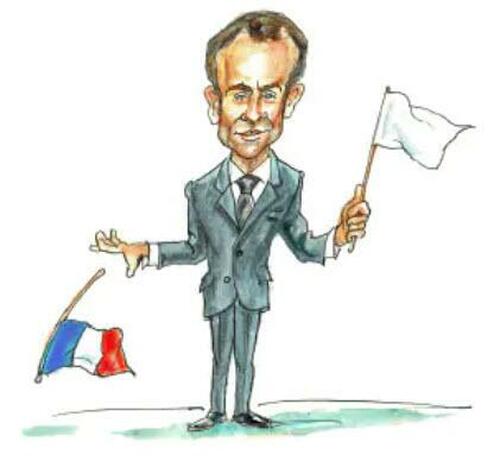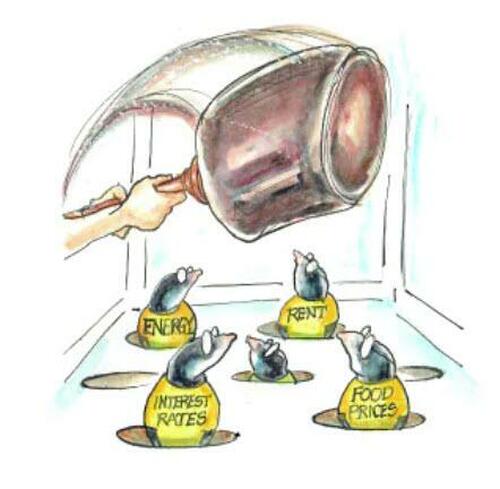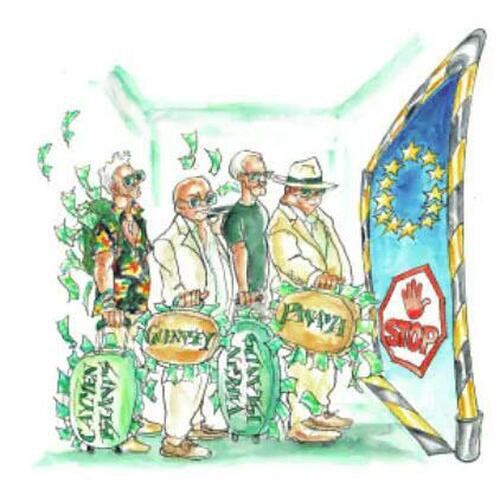Gold To $3000, UnBrexit, & National Meat Bans: Saxo Unveils 2023’s 10 ‘Outrageous Predictions’
Gold almost a double and a further massive collapse in the Japanese Yen are just two of the more reasonable forecasts among Saxobank’s 10 Outrageous Predictions for 2023.
The predictions focus on a series of unlikely but underappreciated events which, if they were to occur, could send shockwaves across financial markets.
“This year’s Outrageous Predictions argue that any belief in a return to the disinflationary pre-pandemic dynamic is impossible because we have entered into a global war economy, with every major power across the world now scrambling to shore up their national security on all fronts; whether in an actual military sense, or due to profound supply-chain, energy and even financial insecurities that have been laid bare by the pandemic experience and Russia’s invasion of Ukraine,” Steen Jakobsen, chief investment officer at Saxo, said in a statement.
While these predictions do not constitute Saxo’s official market forecasts for 2023, they represent a warning against the potential misallocation of risk among investors who might typically assign just a one percent chance of these events materialising.
It’s an exercise in considering the full extent of what is possible, even if not necessarily probable.
Inevitably the outcomes that prove the most disruptive (and therefore outrageous) are those that are a surprise to consensus.
1. Billionaire coalition creates trillion-dollar Manhattan Project for energy
Summary: “It’s the largest research and development effort since the original Manhattan Project that developed the first atomic bomb.” – Peter Garnry & Anders Nysteen
Already rising electricity demand is set to explode, not just from the current and planned electrification via EV’s of our transportation fleets, but also due to the ongoing digitalisation of human activity and the exponential growth in data storage and transmission this creates. The data centre infrastructure needed to service the digital economy continues to grow apace and these centres may consume some 20 percent of global energy in coming decades. At the same time, the growth potential for energy looks highly constrained on the one hand by the unacceptably dirty climate-altering legacy fossil fuels and the frustratingly diffuse and intermittent alternatives like wind and solar.
In 2023, owners of major technology companies and other technophile billionaires grow impatient with the lack of progress in developing the necessary energy infrastructure that would allow them to both pursue their dreams as well as address the needed energy transition. Teaming up, they create a consortium code-named Third Stone, with the goal of raising over a trillion dollars to invest in energy solutions. It’s the largest research and development effort since the original Manhattan Project that developed the first atomic bomb. In addition to pure research and development efforts aimed at realising the potential of current and groundbreaking new technologies, the fund will focus extensively on integration as well, or how to combine new generation sources with the power transmission and energy storage infrastructure that delivers baseload, the Achilles’ heel of current alternative energy solutions.
The fund also dedicates a significant chunk of its investment budget to artificial intelligence (AI), which has shown promise beyond prior expectations of what was possible in some areas of scientific research. A recent example is AlphaFold, an AI programme that made transformational progress in predicting the structures of proteins, a devilishly difficult computational task. The fund aims some initial AI efforts at solving the last wrinkles in solid state battery science, which will drive a leapfrog advance in EV adoption, due to far superior power density and faster charging times.
Market impact: the companies that partner with the Third Stone consortium and can help realise its vision soar in value in an otherwise weak investment environment.
2. French President Macron resigns
Summary: “In a televised address, he criticises the opposition’s standpoint of absolute blockage and announces he is retiring from politics.” – Christopher Dembik.
When President Emmanuel Macron won a second term in May 2022, he believed he could lead France on a royal road to carry out reforms. However, this was before the June 2022 legislative elections when his party and his allies lost their outright majority in Parliament, thus forcing Macron to make compromises. Needless to say, this is something he is not familiar with.
Confronted with a strong opposition from the left-wing alliance NUPES and Marine Le Pen’s far-right National Rally, the government has no other choice but to pass major laws and the 2023 budget by a fast-track decree—triggering the constitution’s article 49.3. Nevertheless, bypassing lawmakers cannot be a way to govern in a democracy. Not in the long run, at least. Macron initially thinks about dissolving the Parliament to organise snap elections. Polls indicate this is not a solution, as it would still lead to a hung parliament. He therefore understands that he will be a lame duck for the next four years and he will not be able to pass his signature pension reform.
Following the example of the founder of France’s democratic system Charles de Gaulle in 1946 and in 1969, Macron unexpectedly decides to resign in early 2023. In a televised address, he criticises the opposition’s standpoint of absolute blockage and announces he is retiring from politics. While France is preparing for a new presidential election, Macron decides to realise his long-time dream of establishing a start-up.
Inwardly, he did not give up on the idea of returning to power. He hopes that his supporters and the silent majority will ask him to come back when France will fall into a political turmoil, as it happened for De Gaulle in 1958. Macron’s resignation opens the door of the Élysée Palace to the far-right contestant Le Pen, thus causing a wave of stupefaction throughout France and beyond, and setting up the latest existential challenge to the EU project and its shaky institutional foundations.
Market impact: Causes a wobble in the euro, but eventually the opposite as the sense of crisis galvanizes an broader anti-populist coalition under new leadership – French OAT sovereign bond yields converge with German Bunds.
3. Gold rockets to USD 3,000 as central banks fail on inflation mandate
Summary: “2023 is the year that the market finally discovers that inflation is set to remain ablaze for the foreseeable future.” – Ole S. Hansen.
In 2023, gold finally finds its footing after a challenging 2022, in which many investors were left frustrated by its inability to rally even as inflation surged to a 40-year high. It turns out that the key in holding down gold’s potential was the market’s mistaken consensus bet that inflation would prove transitory. Central banks largely anticipate that inflation will fall back to target within a mere couple of years, and even the market’s own forward pricing of inflation risks predicts the same. And how was gold supposed to rally in 2022, especially in strong USD terms, if you can get well over 4.0 percent on a 5-year US treasury at a time when 5-year forward inflation rates are priced to drop below 2.5 percent?
2023 is the year that the market finally discovers that inflation is set to remain ablaze for the foreseeable future. Fed policy tightening and quantitative tightening drives a new snag in US treasury markets that forces new sneaky ‘measures’ to contain treasury market volatility that really amount to new de facto quantitative easing. And with the arrival of spring, China decides to pivot more fully away from its zero-COVID policy, touting effective treatment and maybe even a new vaccine. Chinese demand unleashed again drives a profound new surge in commodity prices, sending inflation soaring, especially in increasingly weak USD terms as the Fed’s new softening on its stance punishes the greenback. Under-owned gold rips higher on the sea-change reset in forward real interest rate implications of this new backdrop.
In 2023, the hardest of currencies receives a further blast of support from three directions. First, the geopolitical backdrop of an increasing war economy mentality of self reliance and minimizing holdings of foreign FX reserves, preferring gold. Second, the massive investment in new national security priorities, including energy sources, the energy transition, and supply chains. Third, rising global liquidity as policy makers move to avoid a debacle in debt markets as a mild real growth recession (certainly not in nominal prices, however!) takes hold. Gold slices through the double top near USD 2,075 as if it wasn’t there and hurtles to at least USD 3,000 next year.
Market impact: Spot gold rises above $3,000 per ounce and the VanEck Junior Gold Miners index quadruples in value.
4. EU Army forces EU down path to full union
Summary: “In 2023 it becomes clearer than ever that Europe needs to get the union’s defensive posture in order.” – John Hardy & Christopher Dembik
Any real economic and political union must rank national security as one of its highest priorities, particularly when war looms on that union’s very borders. Since the end of World War II, Western Europe found itself under the comforting umbrella of the US Armed Forces, both directly and via widespread participation in NATO. Since the end of the Cold War, national defence priorities faded further. They mostly only focused on the ‘war on terror’, a diffuse and immaterial threat in real terms even if it loomed large in the public’s imagination, while the active theatres of that war were far-flung, chiefly in Iraq and its environs, and in Afghanistan.
But Russia’s invasion of Ukraine brought the largest hot war to Europe since 1945, and the 2022 US midterm elections saw a strong surge in the right populist Republican representation in Congress, with former president Trump likely set to declare his candidacy for president for 2024. In 2023 it becomes clearer than ever that Europe needs to get the union’s defensive posture in order, being less able to rely on the increasingly fickle US political cycle and facing the risk that the US will entirely withdraw its old commitment to Europe, perhaps after a Ukrainian-Russian armistice.
In a dramatic move in 2023, all EU members move to establish the EU Armed Forces before 2028, with the aim of establishing a fully manned and deployable land, sea, air and space-based operational forces, to be funded with EUR 10 trillion in spending, backloaded over 20 years. An EU Rapid Deployment Capacity force is designated for readiness before 2025, with participation from over 20 EU member countries. To fund the new EU Armed Forces, EU bonds are issued, to be funded based on keys of each member country’s GDP. This drastically deepens the EU sovereign debt market, driving a strong recovery in the euro on the massive investment boost.
Market impact: Leading European defense companies outperform broader European market by 25%, and new popular European defense ETFs are formed and enjoy strong investor interest.
5. A country agrees to ban all meat production by 2030
Summary: “It plans to ban all domestically produced live animal-sourced meat entirely by 2030.” – Charu Chanana.
More than a third of the cereal grains grown globally are used for animal feed and around 80 percent of global arable land is used for grazing animals, some of it claimed from former forest and even rainforest areas. This drives a staggering loss of biodiversity, together with other local environmental impacts like soil erosion and pollution of local water resources from both animal waste and excess fertiliser use on feed crops. On a global scale, food production is responsible for one-third of all planet-heating emissions, with the use of animals for meat accounting for twice the pollution from producing plant-based foods.
Many thought that the energy shock of 2022 would see countries backing down from the commitment to climate as priorities suddenly shifted to merely avoiding blackouts and keeping warm in the coming winters. But we can’t overestimate the rising commitment, particularly in Europe, to climate priorities, even in the face of the current energy shock. And climate change and related policy isn’t just about energy, but also food. To meet the target of net-zero emissions by 2050, one report estimates that meat consumption must be reduced to 24 kg per person per year, compared with the current OECD average of around 70 kg. Countries most likely to consider the food angle on climate change will be those that have legally binding net-zero emissions targets. Sweden has pledged to reach carbon neutrality by 2045, while others like the UK, France and Denmark are aiming for 2050.
But a carrot and stick approach rarely works, and in 2023, at least one country looking to front-run others in marking out its lead in the race for most aggressive climate policy, moves to heavily tax meat on a rising scale beginning in 2025. In addition, it plans to ban all domestically produced live animal-sourced meat entirely by 2030, figuring that improved plant-derived artificial meats and even more humane, less-emissions intensive lab-grown meat technologies will have to satisfy appetites to help save the environment and climate.
Market impact: Equities like traditional “ESG-lite” Tyson foods suffer steep drawdowns until they begin investing in sustainable and even lab-grown meat.
6. UK holds UnBrexit referendum
Summary: “Supply side tax cuts and demand-boosting subsidies for energy are a toxic cocktail for a country’s bond and currency markets.” – Jessica Amir.
The record brief tenure of UK Prime Minister Liz Truss in 2022 made the UK policy dilemma clear: supply side tax cuts and demand-boosting subsidies for energy are a toxic cocktail for a country’s bond and currency markets when that country runs massive twin budget/trade deficits. Taking over from the Truss-Kwarteng duo in 2022 was the Rishi Sunak-Jeremy Hunt duo, who only deliver depressing fiscal austerity via tax hikes and spending cuts. Does it increase the sustainability of the UK debt trajectory? For a time, maybe. But it’s just an alternative toxic cocktail to a crack-up inflationary reset that Truss-Kwarteng might have delivered, had it been given a chance.
In 2023, Sunak-Hunt manage to take Tory popularity ratings to unheard-of lows as their brutal fiscal programme throws the UK into a crushing recession, with unemployment soaring and, ironically, deficits soaring too as tax revenues dry up. Public demonstrations break out, demanding that Sunak call snap elections because of the lack of a popular mandate. Amidst the economic ruin, polls even in England and Wales indicate second thoughts on the wisdom of Brexit. Many note that the overwhelming majority of the young generation were in favour of Remain in the first place, with over 80 percent of 18- to 24-year-olds voting Remain, versus nearly two-thirds of those aged 65-plus voting to leave, many who have since passed away and very few of whom are still in the labour force.
Sunak finally caves and calls an election, resigning to allow a new Tory profile to take charge of the battered party. Labour leader Keir Starmer, noting the popular support for a second Brexit referendum and the Lib Dems surging in the polls as they clamour for a new referendum, runs on a platform of non-alignment on the Brexit question but supports a second referendum to rejoin the EU along the lines of the David Cameron deal struck before the original 2016 referendum. A Labour government takes power in Q3, promising an UnBrexit referendum for November 1, 2023. The ReJoin vote wins.
Market impact: after a weak performance in early 2023, GBP recovers 10 percent versus the EUR and 15 percent versus the CHF on the anticipated boost to the London financial services sector.
7. Widespread price controls are introduced to cap official inflation
Summary: “In a war economy, the government hand will expand mercilessly as long as price pressures threaten stability.” – Steen Jakobsen.
Inflation will remain a challenge to control as long as globalisation continues to run in reverse and long-term energy needs remain unaddressed.
Nearly all wars have brought price controls and rationing, seemingly as inevitable as battle casualties. The list of precedents stretches at least as far back as the Roman emperor Diocletian trying to set maximum prices for all commodities in the late third century AD. Over the last century-plus we saw comprehensive price controls and rationing in the two world wars. And even without the context of war, price and even wage controls were implemented during the peak statist years under UK Prime Minister Wilson and even US President Nixon.
2022 has also seen early and haphazard initiatives to manage inflation. Taxes on windfall profits for energy companies are all the rage while governments are failing to use the classic tool of rationing supplies. Instead, they are actively subsidising excess demand by capping heating and electricity prices for consumers. In France, this simply means that utilities go bankrupt and must be nationalised. The bill is passed to the government and then to the currency via inflation. Then we have the likely doomed effort by western officials to cap Russian energy prices from December 5. The intent is to starve Russia of revenue and hopefully cheapen crude oil export prices everywhere, but it will likely do neither.
In a war economy, the government hand will expand mercilessly as long as price pressures threaten stability. The thinking among policymakers is that rising prices somehow suggest market failure and that more intervention is needed to prevent inflation from destabilising the economy and even society. In 2023, expect broadening price and even wage controls, maybe even something like a new National Board for Prices and Incomes being established in the UK and the US.
But the outcome will be the same as it is for nearly every government policy: the law of unintended consequences. Controlling prices without solving the underlying issue will not only generate more inflation but also risking tearing at the social fabric through declining standards of living due to disincentives to produce, and misallocation of resources and investment. Only market-driven prices can deliver improved productivity and efficiency through investment. Looks like we’ll have to learn the lesson all over again in 2023 and beyond.
Market impact: please see Outrageous Prediction on gold rocketing to USD 3,000.
8. OPEC+ & Chindia walk out of the IMF, agree to trade with new reserve asset
Summary: Recognising the ongoing weaponisation of the USD by the US government, non-US allied countries move to leave the USD and the IMF to create an international clearing union (ICU) and a new reserve asset, the Bancor (currency code KEY), using Keynes’ original idea from the pre-Bretton Woods days to thumb its nose at the practices of the US in leveraging its power over the international monetary system.
While less than a fifth of international trade is destined for the US, over a third of international trade is invoiced in USD and nearly 60 percent of global foreign exchange reserves are USD. The ban on transactions with Russian sovereign entities in February 2022 after Russia’s invasion of Ukraine sent shockwaves across countries not allied militarily with the US as the magnitude of the ban far exceeded sanctions on Iran, Venezuela and other countries in recent decades. These countries wonder whether their US assets—and even EUR, JPY and GBP assets—could be subjected to freeze orders imposed by the US Treasury and other US allies overnight.
Many have speculated that the Chinese renminbi might become the new reserve currency, but China has shown no interest in abandoning cross-border capital controls. Another important aspect hampering the use of CNH in trade is that many non-US allies are wary of China’s rise in influence and power.
Rather, a natural solution for China and its many trading partners, particularly energy and other commodities exporters, would be to find a new non-national currency reserve asset upon which to trade. They find inspiration in British economist John Maynard Keynes’ playbook for reconstructing a post-World War II international monetary system without a hegemon. In an epochal conference convened in Astana, Kazakhstan, leaders from OPEC+ countries, mainland China, Hong Kong, India, Brazil, Pakistan, Central Asia countries, and tens of African Union countries gather to establish an ICU based on a new accounting unit and reserve asset: the Bancor (currency code KEY). The KEY can only be held by member central banks and is used as an accounting unit to settle international trades and as a reserve asset. The new KEY is indexed to a basket of traded commodities with crude oil having the largest weight. The currencies of member countries are backed by the KEY at fixed exchange rates and are adjusted according to relative current account shifts among member countries. All the ICU member countries of the newly created monetary union withdraw from the IMF. Saudi Arabia and Hong Kong end their currency pegs to the USD.
Market impact: Non-aligned central banks vastly cut their USD reserves, US Treasury yields soar and the USD falls 25 percent versus a basket of currencies trading with the new KEY asset.
9. USDJPY fixed to the USD at 200 as Japan overhauls financial system
Summary: “Japan’s real GDP drops by 8 percent.” – John J. Hardy.
Japan mobilised hundreds of billions of USD in its currency reserves in 2020 to defend the Bank of Japan’s (BoJ) unmoved monetary policy and the JPY itself as the BoJ refused to hike the policy rate from -0.1 percent or to lift the yield cap on 10-year Japanese government bonds at 0.25 percent. As 2022 rolls into 2023, the pressure on the JPY and the Japanese financial system mounts again on the global liquidity crisis set in motion by the vicious Fed policy tightening and higher US treasury yields.
Initially, the BoJ and Ministry of Finance deal with the situation by slowing and then halting currency intervention after recognising the existential threat to the country’s finances after burning through more than half of central bank reserves. But as USDJPY rises through 160 and 170 and the public outcry against soaring inflation reaches fever pitch, they know that the crisis requires bold new action. With USDJPY soaring beyond 180, the government and central bank swing into motion.
First, they declare a floor on the JPY at 200 in USDJPY, announcing that this will only be a temporary action of unknown duration to allow for a reset of the Japanese financial system. That reset includes the BoJ moving to explicitly monetise all its debt holdings, erasing them from existence. QE with monetization is extended to further lower the burden of Japan’s public debt, but with a pre-set taper plan over the next 18 months. The move puts the public debt on course to fall to 100 percent of GDP at the end of the BoJ operations, less than half its starting point. The BoJ policy rate is then hiked to 1.00 percent and all yield-curve control is lifted, which allows the 10-year rate to jump to 2.00 percent.
Banks are recapitalised as needed to avoid insolvency and tax incentives for repatriating the enormous Japanese savings held abroad see trillions of yen returning to Japanese shores, also as Japanese exports continue to boom. Japan’s real GDP drops by 8 percent on reduced purchasing power even as nominal GDP rises 5 percent due to cost of living increases, but the reset puts Japan back on a stable path and establishes a tempting crisis-response model for a similar crisis inevitably set to hit Europe and even the US eventually.
Market impact: USDJPY trades to 200 but is well on its way lower by the end of the year.
10. Tax haven ban kills private equity
Summary: “The OECD agrees in 2023 to move to a more aggressive stance on tax havens, launching a full ban on the largest tax havens in the world.” – Peter Garnry.
In 2016, the EU introduced an EU tax haven blacklist identifying countries or jurisdictions that were deemed ‘non-cooperative’ because they incentivize aggressive tax avoidance and planning. This was in response to the leaked Panama Papers, a trove of millions of documents that revealed tax cheating by wealthy individuals including politicians and sports stars. However, that blacklist excluded the biggest tax havens, in part due to effective lobbying. Thus, the global tax haven ecosystem continues to thrive. And it’s not just wealthy individuals that are heavy users of tax havens—entire industries such as private equity and venture capital also leverage tax haven vehicles like offshore feeder funds to attract capital from foreign investors in different tax jurisdictions.
As the war economy mentality deepens further in 2023, national security perspectives turn increasingly inward to industrial policies and the protection of domestic industries. As defence spending, reshoring and investments in the energy transition are expensive, governments look for all available potential tax revenue sources and find some low-hanging fruits in haven-enabled tax dodgers. It is estimated that tax havens cost governments between USD 500 and USD 600 billion annually in lost corporate tax revenue.
Based on advice from economic advisors that tax havens offer little economic purpose, the OECD agrees in 2023 to move to a more aggressive stance on tax havens, launching a full ban on the largest tax havens in the world such as the Cayman Islands, Bermuda, The Bahamas, Mauritius and the Isle of Man. The ban means that corporate acquisitions in OECD countries cannot be made with capital arriving from tax haven entities and only from OECD countries or countries that adopt OECD transparency standards on capital, which would include automatic exchange of information, beneficial ownership registration and country-by-country reporting.
In the US, the carried interest taxed as capital gains is also shifted to ordinary income. The EU tax haven ban and US change to the carried interest taxation rule jolts the entire private equity and venture capital industries, shutting down much of the ecosystem and seeing publicly listed private equity firms dealt a 50 percent valuation haircut.
Market impact: iShares Listed Private Equity UCITS ETF falls 50 percent
* * *
How many of these 10 will come true? Who knows, but they should all be on the table as possibilities in this mad, mad world.
Tyler Durden
Tue, 12/06/2022 – 07:46
via ZeroHedge News https://ift.tt/sEzWMpd Tyler Durden









